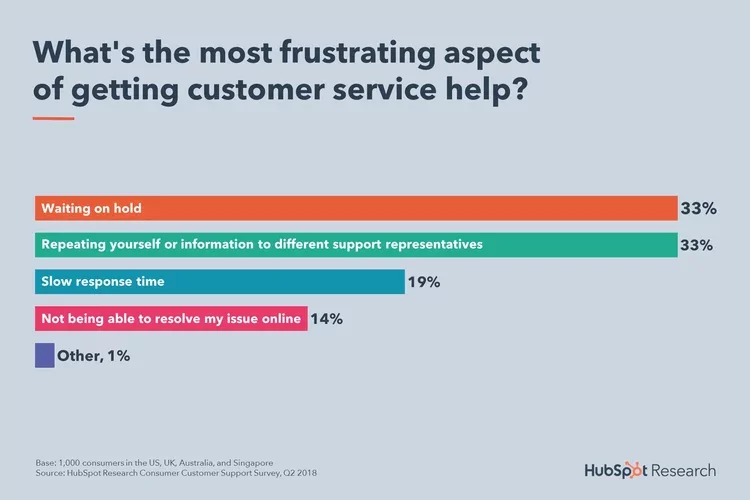It happens in a single glance. The data says we only need one look at someone for a solid first impression. And that glance only takes about 33 milliseconds.
According to Business Insider, these first impressions say a lot: whether the other person is a natural leader, whether they’re smart, whether they’re trustworthy, whether they’re friend or foe.
The first impression is the seed of every relationship. And it’s even more important in customer service, where 90% of customers use these first interactions as a barometer for their future brand loyalty.
But building a strong first impression through good intentions isn’t enough. Your customer service might be friendly, but friendliness alone won’t win customer loyalty. We already know, for example, that small talk doesn’t work when customers just want quick solutions.
If you’re going to make a good first impression — a positive interaction that drives future customer loyalty — then you’re not only going to know how to approach it. You’re going to have to know how customers want these first impressions to go down.
First, set the context by understanding the customer journey
A smile and a friendly chat. Those are two key ingredients to pleasing every customer, right?
Not exactly. They’re certainly baseline ingredients: no customer wants to talk to a grumpy employee. But sometimes a friendly approach will only get you so far.
To truly delight your customers, you have to understand the context from which they’re reaching out to you. Research suggests 69% of customers contact you because they’re already in the middle of trying to solve a problem. Your job isn’t to talk their ears off with overt friendliness. Your job is to give them a solution as soon as possible.
(As we noted in our Building customer relationships post, too much small talk can sometimes frustrate people and work against you.)
According to the Harvard Business Review (HBR), a customer’s expectation is one of the biggest factors in forming their first impression. For instance, someone riding an exercise bike for the first time is going to want to break a sweat during their first workout, whereas the average SaaS user is just going to want a seamless experience.
It’s up to you and your customer-facing team to determine what customers want, then build a first impression that delivers it to them.
Great first expectations in customer service start with meeting expectations
To create a powerful first impression, your temptation will be to go “above and beyond” for your customers. And that’s great. But be wary of losing sight of why customers are reaching out to you in the first place.
According to the HBR, it helps to understand the four types of customer journeys before you figure out the kind of experience you want your customers to have. HBR notes there are four archetypes for a great customer experience:
Archetype #1: Routine
A routine is effortless but predictable. This is the customer service experience we typically expect when we reach out to ecommerce outlets and SaaS companies.
Don’t be fooled by the word “routine.” Here we want routine. A SaaS customer with a software issue wants things to work as expected. And if your customer support is good, the solution should be effortless.
If you’re reaching out to a company to return a pair of sunglasses, for example, you don’t want an unpredictable experience. You want smooth, easy — customer service without a hitch.
Archetype #2: Joyride
The joyride experience should be just as effortless, but it should delight us in surprising ways. Think of it as both effortless and unpredictable. This is where going above and beyond really has a lasting impact.
For example, a hotel with a concierge who offers you hospitality services beyond what you expected when you booked the room is going to delight you here. Or when you eat at a Michelin-star restaurant, you often go there to avoid a routine restaurant experience. You still want effortless — you just want it in a way that surprises you and makes you say “wow!”
Archetype #3: Trek
If you want a predictable but effortful experience, you’re after the trek.
Every time you get on your at-home exercise bike, you know what you’re signing up for. Yet you still know that if it doesn’t require any effort on your part, you’re not getting the full experience.
Archetype #4: Odyssey
Both effortful and unpredictable, the odyssey is a set of difficult surprises you signed up for.
When you enlist a personal trainer at your local gym, you know that effortful, unpredictable workouts are part of the experience. If your first experience with a personal trainer was routine, meaning low-effort and unsurprising, what impression would you have? You might start thinking that you shouldn’t have signed up.
To nail the first impression, you have to work within the boundaries of these customer expectations. You’ll best delight your customers when you know what experience they prefer.
That’s why a good first impression isn’t only about being polite. If your customer were in the desert dying of thirst, the best possible first impression would be to hand them a glass of water. If they’ve come for a good workout, your job is to challenge them in unexpected ways, not to be so easy on them that they never break a sweat. According to Salesforce, “excellent customer service” means 89% of customers will return to you, even if you make a mistake.
Get the little things right to make a strong first impression
Understanding customer context is critical. But your customer service still has the responsibility to deliver these offerings in a way that’s responsive, polite, and helpful.
If you’re handing a glass of water to your thirsty customer, then you have one part right: the solution to their problem. But if you keep pulling the glass back when they reach for it — making them jump through hoops, or maybe sign up for your newsletter first — they can get resentful in a hurry. And there goes your positive first impression.
To master the “little things,” you’ll need a way to measure how effective your customer service teams are. And once you measure these variables, you’ll find ways to improve them.
Response time
Response time isn’t only about how quickly customers find a solution. That’s a great variable to manage, sure. But response time refers explicitly to how quickly you initiate an interaction when a customer reaches out.
It won’t do you much good to solve 100% of customer problems…after making them wait on hold for an hour. Most customers will just drop off. According to HubSpot research, 60% of customers don’t want to wait beyond single-digit minutes for their response. Otherwise, they’ll start getting antsy.
In the same research, 82% of customer respondents said immediate responses were either “important” or “very important” when reaching out with sales-related queries. More than that (90%) said the same when they had a customer support issue.
If you want a good first impression, don’t make anyone wait. Use auto-responders so customers know you’ve received their query, then route incoming calls to shared phone numbers so you can put an entire team’s worth of resources toward each call.
Response quality
Is a customer talking to a chatbot who obviously wants to direct customers away from live help and toward an unhelpful resource library? Speed alone isn’t enough. We all know how frustrating it can be to reach out to a company, only to be transferred, forwarded, and auto-responded out of existence.
If a customer has a problem, how quickly can they reach a genuine representative who can help? If you do add service automation to your incoming queries, personalize it. In the next section, we’ll explore one company that improved its response quality with personalization that required no extra effort.
A single source for responses

Transfer, transfer, transfer, please hold. It’s not a great first impression. According to HubSpot, too many customer support transfers were the only variable as frustrating as long wait times.
Use your customer relationship management platform to route customer queries to the right department every time. And if your backend customer support software has team collaboration tools that customers can’t see, you can eliminate the need to endlessly transfer calls.
Using technology to drive a great first impression
You might notice that many of the solutions above rely on technology to help. And that’s a good thing. If your customer relationship systems make your first impressions easier to manage, you can’t help but improve. But let’s get specific about how technology can help:
- Building an omnichannel customer journey: With OpenPhone, you can use omnichannel communications to reach out to customers on the media they prefer. This reduces the feeling that they’re constantly being “transferred” to new teams.
- Analytics: If you can view response times on a single dashboard, you have a way to manage response time and improve the quality of your first impressions over the long haul.
- Automation: Carry used OpenPhone to auto-generate personalized responses, giving them both fast response times and improved response quality without additional effort. They also used OpenPhone to create team-wide communication to handle customer queries.
Want to make a more powerful first impression? Read this.
Think about the businesses you love the most. Chances are there was a powerful first impression in there somewhere — a moment of decision where you said: “Yep, this is the company for me.”
We human beings are wired to take a lot out of a first impression. Once we’ve made up our minds about our relationships, it’s hard to get us to change them. In building customer relationships, you can make this effect work for you. Delight your customers, understand their needs in context, and use technology to drive happy experiences.
Want to know more about the first impression—and what to do after the first interaction? Read more about building customer relationships the right way.
